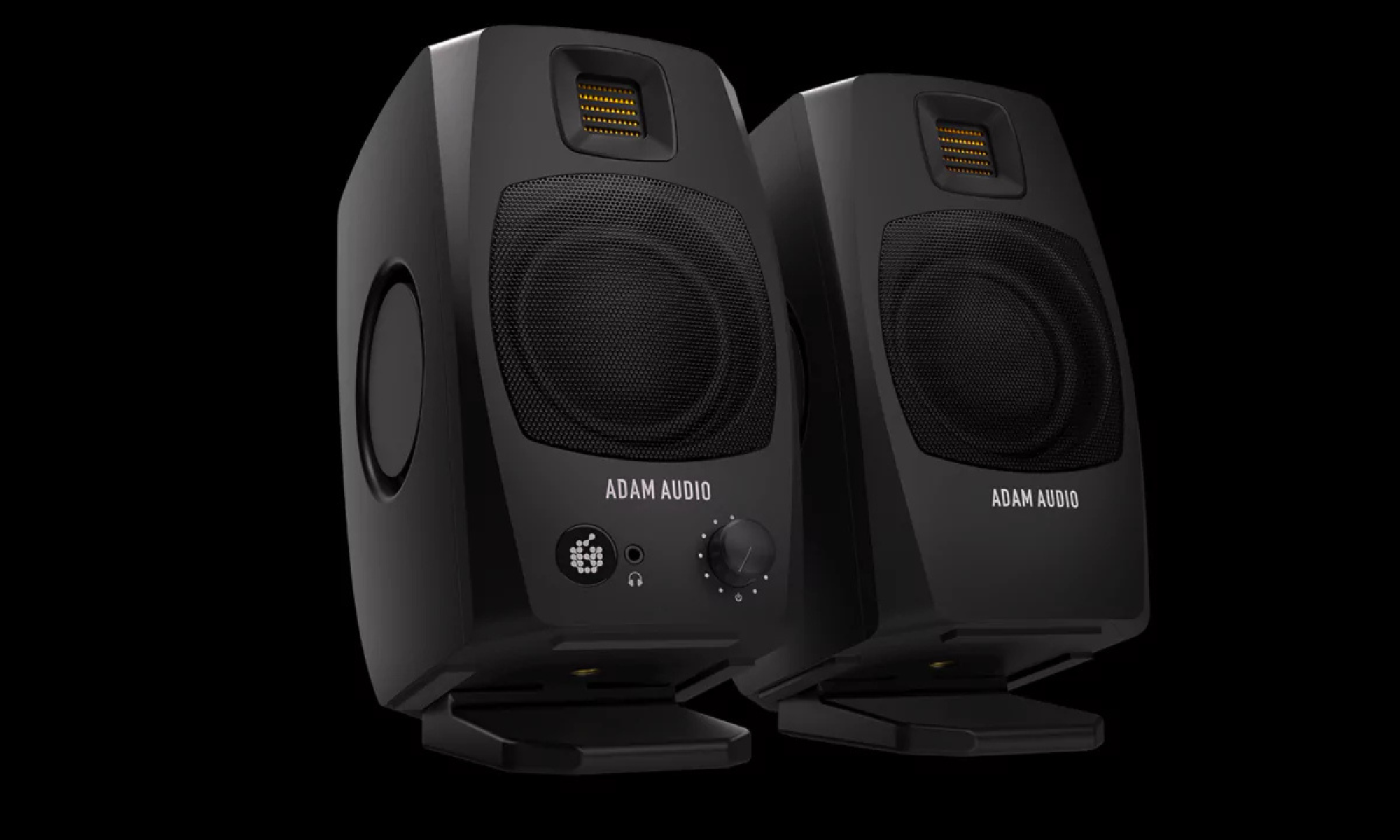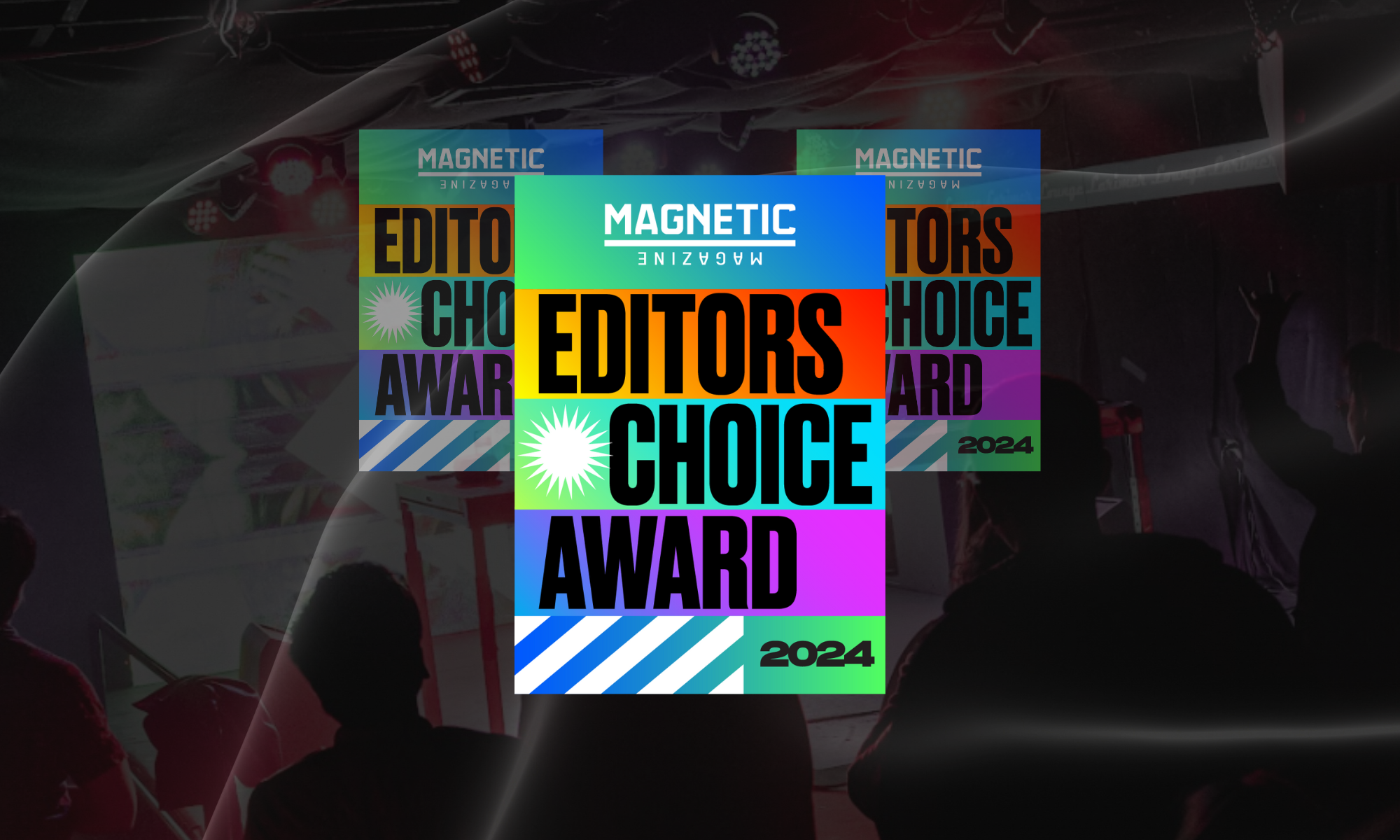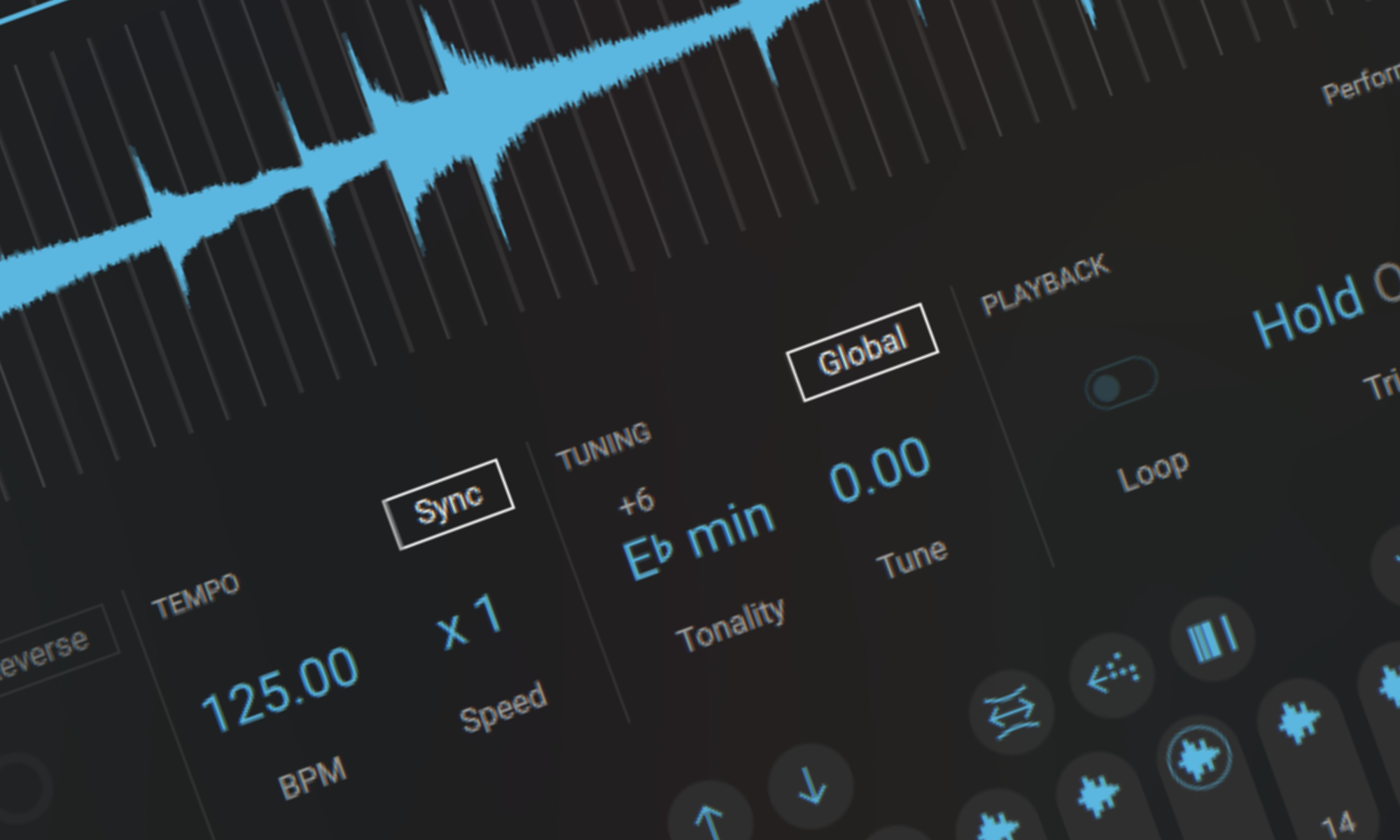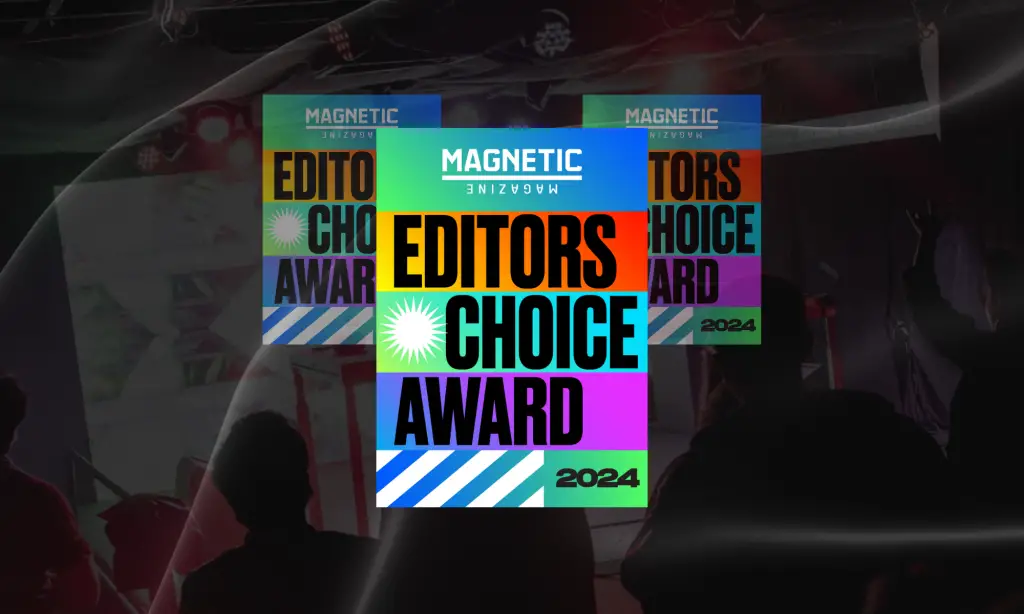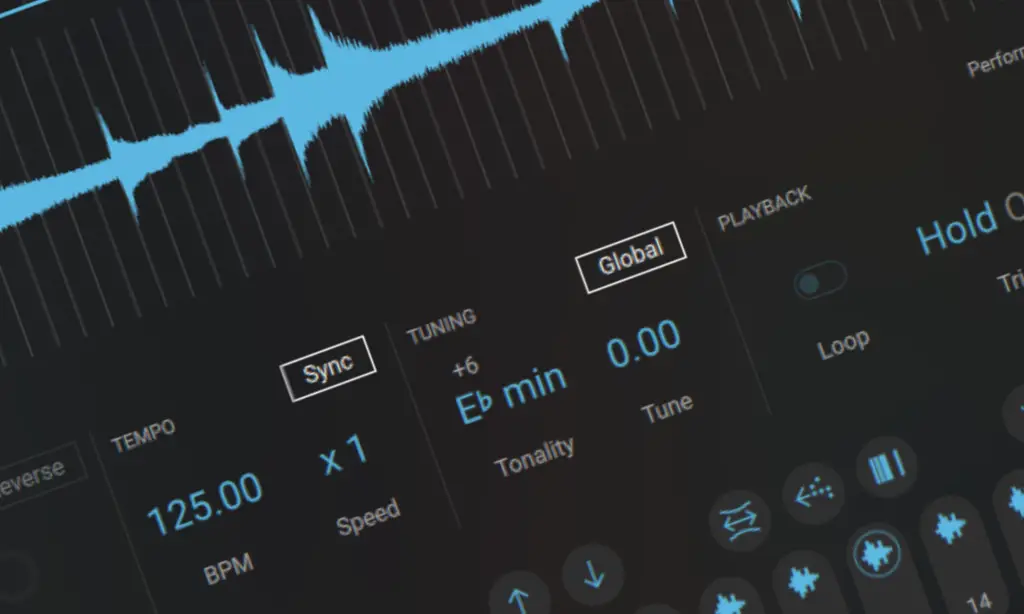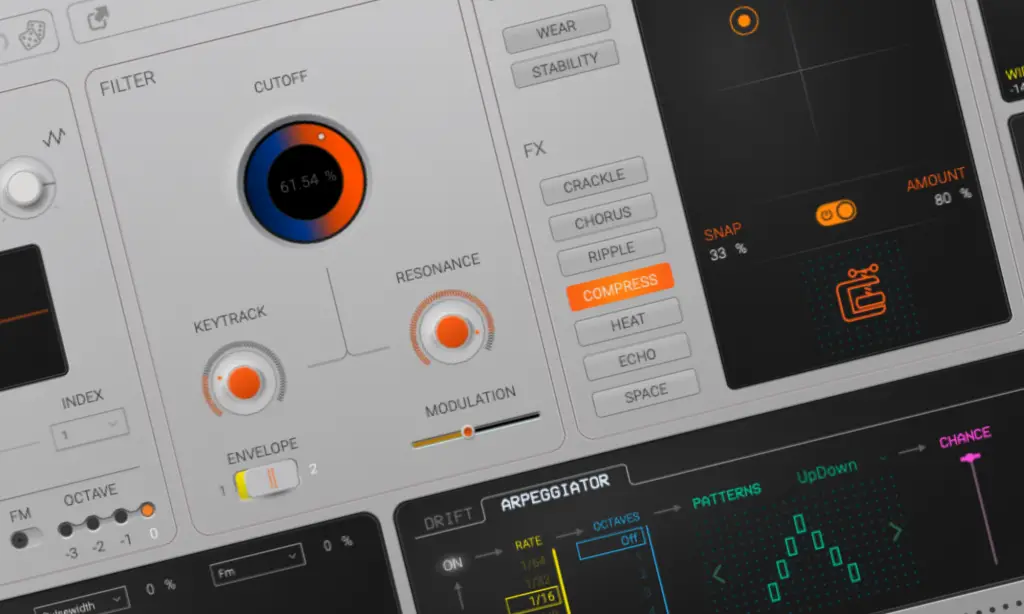Table of Contents
Adam Audio has been producing gear aimed at top-level engineers for decades, making their brand synonymous with industry-standard, high-quality equipment. They’ve been a staple in the eyes, ears, and studios of many experienced engineers who have been in the game for years. However, in recent years, Adam Audio has been focusing on finding ways to serve a new wave of engineers, producers, and artists. These newer creatives want to tap into Adam Audio’s legacy but might not have the resources or the studio setup to justify investing in their premium offerings.
To address this, Adam Audio has been shifting toward creating more accessible gear that still meets the high standards their reputation is built on. The new range of desktop monitors, the D3Vs, is a perfect example of this shift. In this article, we’ll cover everything they offer—from the key features and use cases to the pros, cons, and any potential concerns—giving you a well-rounded and honest review.
One standout feature is that the D3Vs come as a pair right out of the box, so purchasing an additional monitor is unnecessary. They arrive ready to use, making the setup process seamless. With that said, let’s dig into some of the specifics.
ADAM Audio D3V Monitors Review – Editor’s Choice Awards
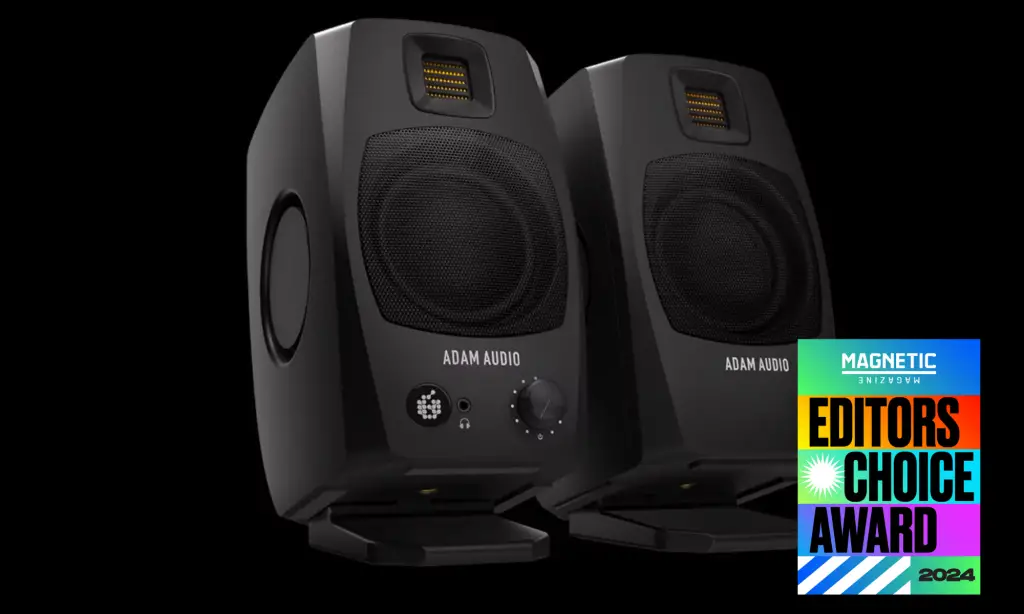
Last year, when we introduced the Editor’s Choice Awards, our goal was to spotlight products that truly stand out as best in class. In today’s market, especially in 2024, there are countless products being released, but not all of them reinvent the wheel. The Editor’s Choice Award is a chance to highlight those standout products that excel in their specific purposes. The D3V monitors are a prime example of a portable and user-friendly desktop monitoring system.
While I have the IK Multimedia iLoud MTM MK2s in my main studio for ultra-nearfield monitoring, the Adam Audio D3Vs have become my go-to for portable use. They allow me to change up my creative listening environments, which has been crucial for my creative process over the past few months. The portability of the D3V monitoring system has been a game-changer and is well-deserving of the Editor’s Choice Award as we near the end of 2024.
Key Features and Specifications
Design and Build
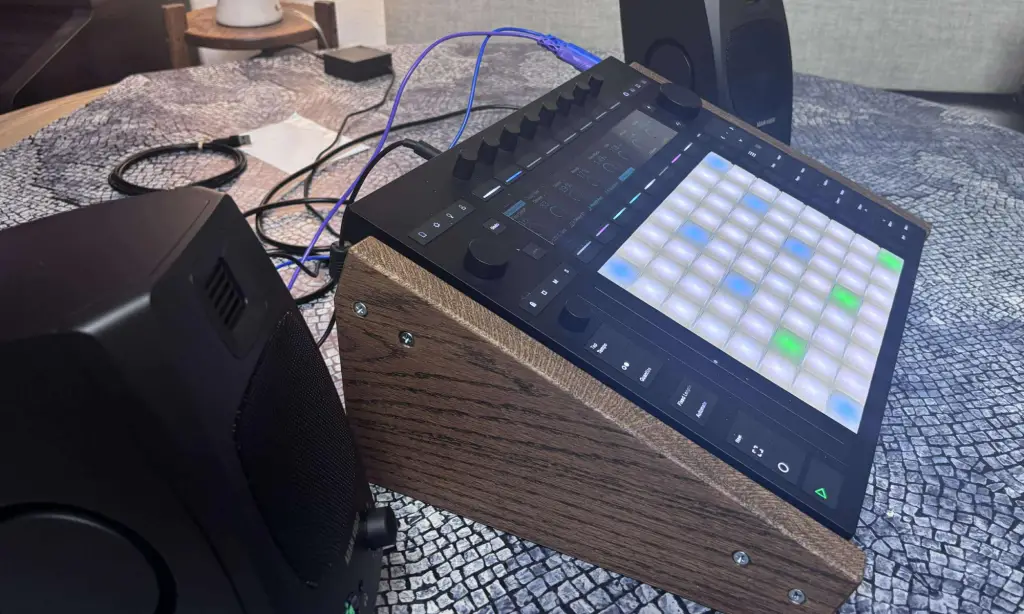
With a line of monitors that prioritize desktop-friendly design, it’s impossible not to start with their build and design features. The D3V stands out for its clean and compact design, standing just over 8 inches tall and weighing 8 pounds. The ABS polycarbonate construction offers durability and portability, ensuring these monitors can handle frequent repositioning and travel while maintaining a sleek and professional look.
Another notable feature is their user-friendly design. The angled stands improve listening angles right out of the box, and the included desktop pads help reduce vibrations on less-than-ideal surfaces, like IKEA desks often doubling as studio desks. Mounting monitors is always the best option, and threaded mic stand inserts on these monitors allow for easy integration into more complex setups.
Finally, the packaging includes everything you need right out of the box: USBC cables, adapters, and the angled stands mentioned above. For new users looking for an all-in-one setup, these desktop monitors are fantastic options right from unboxing to setup. They also adapt well as you level up your setup with additional monitor stands and more.
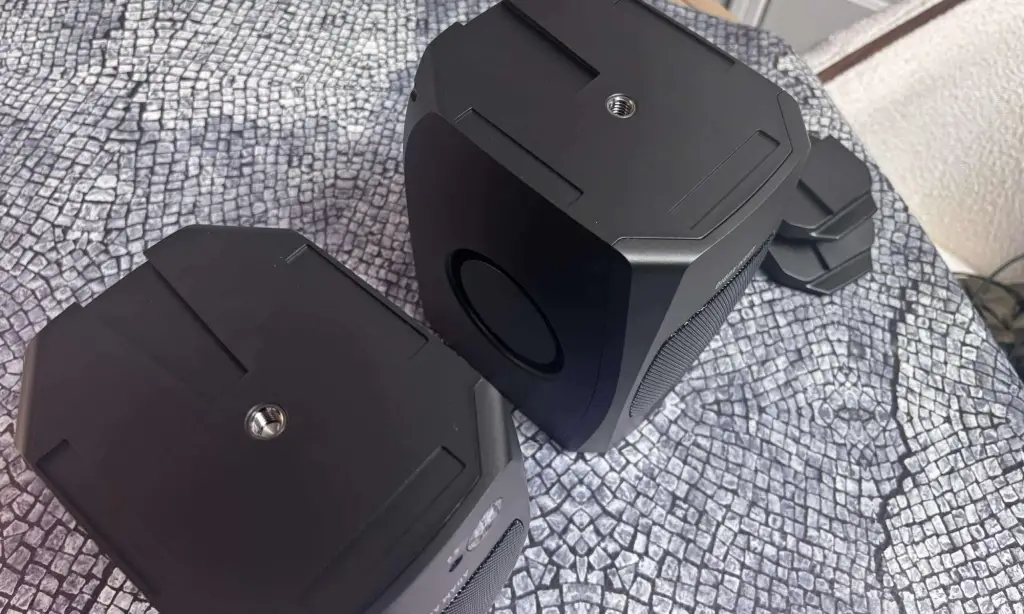
Drivers and Amplification
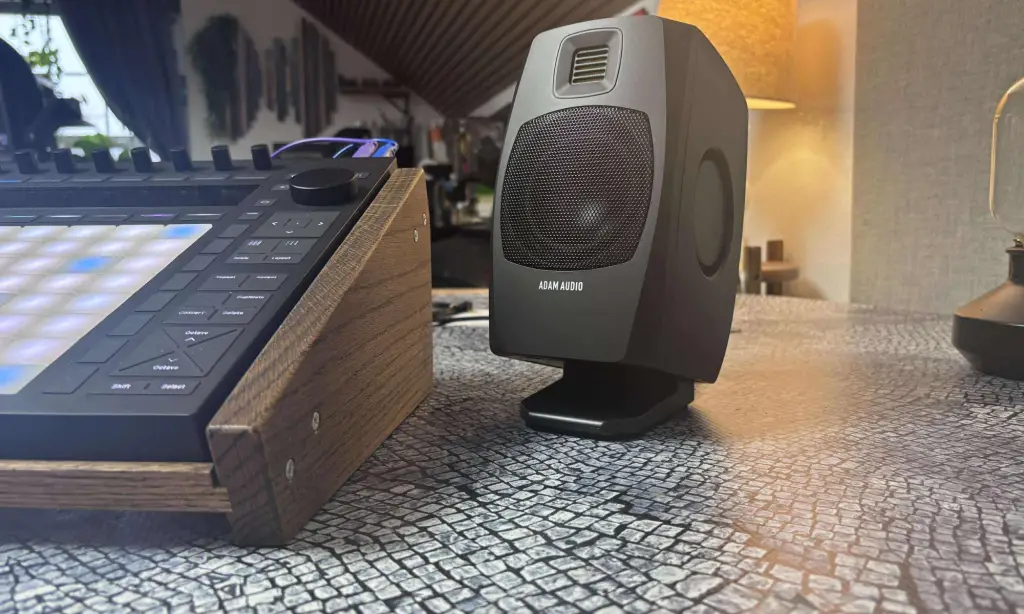
ADAM Audio’s D3V packs a 3.5-inch aluminum woofer paired with dual passive radiators. Together, they push out bass that sounds way bigger than you’d expect from a monitor this size. For the highs, it uses ADAM Audio’s D-ART ribbon tweeter—something they’re known for—and it delivers that crisp, detailed sound that works equally well for precise mixing or just casual listening.
The bi-amped design splits the power smartly: 80 watts to the woofer and 40 watts to the tweeter. That setup keeps the sound clean and balanced, even when you crank the volume. Whether it’s handling a heavy bass line or intricate vocal work, it keeps distortion out of the picture. And no matter how loud you go, the balance between highs and lows stays consistent.
Compared to other monitors in its range, the D3V really gets ahead of the pack in terms of power and clarity (especially for its price point, but we’ll cover that in a bit). Whether you’re tweaking a podcast, mixing a track, or just vibing to your favorite record, these monitors consistently deliver performance that feels like it belongs in a higher price bracket.
Connectivity
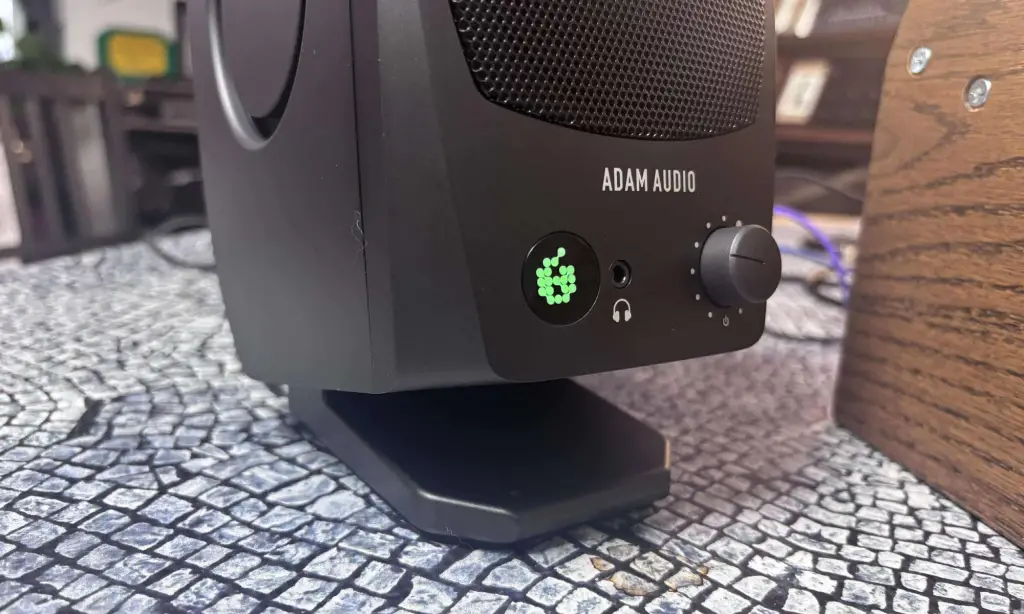
The D3V’s connectivity options are where modern design meets practical functionality. Equipped with both TRS analog inputs and USB-C digital connectivity, the D3V adapts to virtually any setup. The USB-C input is particularly noteworthy, allowing users to connect directly to computers, smartphones, and even tablets without needing an external interface. This streamlined approach is a game-changer for beginners or anyone looking to simplify their workflow.
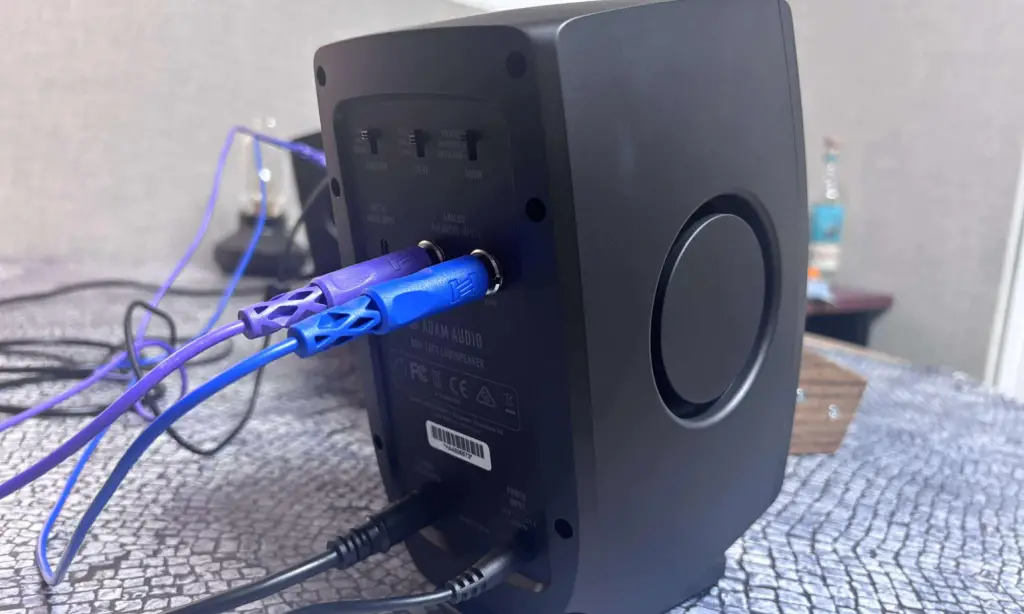
Another feature worth highlighting is the front-mounted 3.5mm headphone jack. This addition makes switching between monitors and headphones effortless, a convenience that’s often overlooked in monitors at this price point, and, if you’re somebody needing desktop monitors for your studio, having multiple, highly-accessible referencing options to check your mixes is worth its weight in gold. Whether you’re working on a mix late at night or need to isolate certain elements of a track, the headphone jack ensures smooth transitions without disrupting your creative flow.
By catering to both analog and digital workflows, the D3V positions itself as a flexible option for a wide range of users. Whether you’re a hobbyist, content creator, or seasoned professional, these monitors integrate seamlessly into your setup.
DSP and Room Optimization
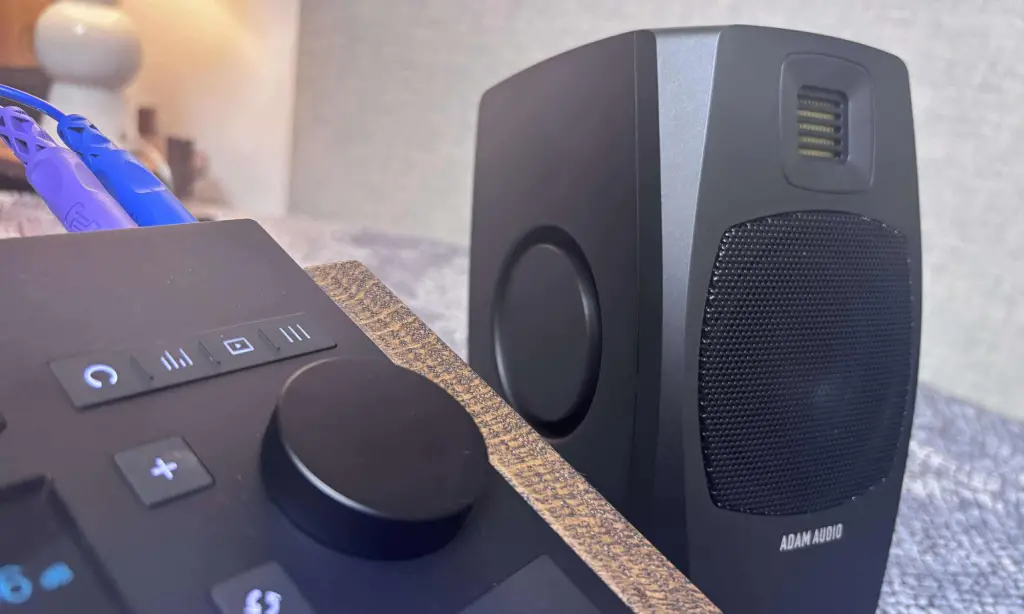
Acoustics are a challenge in any studio, but the D3V’s built-in DSP makes it easier to manage (even in less-than-ideal spaces like odd-shaped bedrooms or side spaces). On the back, you’ve got three simple EQ switches that let you adjust for placement (stand, wall, or desk), desk size (small, medium, or large), and room treatment (treated, semi-treated, or untreated). While it’s not the most detailed system out there which might deter somebody who has been around the block more than a few times, it’s flexible enough to make a real difference in spaces that aren’t acoustically perfect and will take most of the fine-tuning and heavy lifting off the shoulders of newer users who want something that just want to plug, play, tweak, and create.
What’s great about these DSP settings is how straightforward they are too.
There’s no need to deal with complicated software or lengthy calibration. It’s just manual adjustments that actually work. For example, switching from “wall” to “stand” placement can clean up bass reflections, and the “desk” setting helps reduce midrange buildup caused by reflective surfaces.
This might feel limited if you’re an advanced user looking for granular control. But for anyone working in multi-purpose or temporary spaces, the D3V’s DSP gets the job done. It gives you reliable sound without needing to invest heavily in acoustic treatments.
Frequency Range and Output
The D3V offers a frequency range of 45Hz–23kHz, giving you full-spectrum sound that works for mixing, mastering, and casual listening. With a max SPL of 96dB, it’s a solid fit for small to medium-sized spaces. While the bass doesn’t dive into subwoofer territory, it’s tight, controlled, and balanced, making it versatile across most genres.

The ribbon tweeter delivers sharp, detailed highs, so subtle elements in your mix still definitely stand out. For the low end, the dual passive radiators help boost depth and fullness without introducing distortion, even when the volume is cranked up though it doesn’t give much bass attenuation, which means that the ultra-lows of the mix lack the warmth of larger monitors. That isn’t a gripe on these monitors specifically, as it’s basically a thing with every monitor of this size, but it is worth mentioning.
Thanks to its solid frequency response and consistent performance, the D3V handles a wide range of tasks with ease. Whether fine-tuning intricate tracks or playing a playlist, it keeps the sound clear and reliable.
Strengths
Its Sound
The D3V’s sound quality is what really sets it apart. The D-ART ribbon tweeter does the heavy lifting here, giving you crisp, precise highs that let you hear those subtle details in your mix you might miss on other monitors in this price range. It’s the kind of clarity that makes a big difference when you’re working on intricate tracks.
The dual passive radiators pull their weight on the low end, adding depth and fullness without muddying the mix. Sure, it doesn’t reach the low-end rumble of bigger woofers, but the bass is tight and balanced enough to handle most genres with confidence. The mids also feel right on point, keeping vocals and instruments clear and natural in the mix.
Altogether, the D3V’s sound is clean, balanced, and detailed, making it a solid tool for producers who need their mixes to translate well across other systems. It’s the kind of monitor that rewards paying attention to the small stuff.
It’s Compact
The D3V nails it when it comes to compact design. Its small footprint makes it perfect for home studios, dorm rooms, or portable setups where space is tight. Even with its size, it doesn’t cut corners—ADAM Audio kept the sleek, professional build quality they’re known for.
The angled stands are a smart touch, giving you a better listening angle right out of the box while keeping the monitors stable. If you need more flexibility, the mic stand mount option is a huge bonus. It makes the D3V a great fit for unconventional setups or temporary workspaces.
Whether you’re working in a tight home studio or packing up for a mobile setup, the D3V’s design feels practical and well thought out. It integrates smoothly into your workflow without taking up more space than necessary.
Convenience
The D3V is ready to roll right out of the box. ADAM Audio includes everything you need—cables, adapters, and accessories—so setup is quick and painless. For newer producers or anyone not familiar with studio gear, it takes a lot of the guesswork out of getting started.
The USB-C connectivity is a standout feature, letting you skip the traditional interface and connect straight to your device. It keeps your workflow simple and your gear minimal, which is a win for smaller setups. Add in the front-facing headphone jack, and the D3V brings a level of flexibility you don’t usually see at this price point.
Potential Limitations
Bass Limitations
The D3V’s 3.5-inch woofer has limits, as I mentioned above. While the dual passive radiators boost the low end, it might not cut it for producers working on bass-heavy genres like EDM or hip-hop. If you’re in that space, adding a subwoofer like ADAM Audio’s T10S could fill the gap—but it’s an extra expense that not everyone can justify.
That said, for most genres and everyday use, the bass is tight, accurate, and balanced. It holds up well for general mixing and critical listening, making the D3V a solid choice if you’re not relying on heavy low-end reproduction.
Customization Limitations
The DSP features on the D3V are simple and easy to use, but they don’t offer the fine-tuning you’d get with more advanced systems. If you’ve got specific acoustic needs or a tricky room to work with, the three EQ switches might feel a bit limiting.
That said, the DSP settings are a good match for the D3V’s audience. In most home studio setups, the adjustments make a noticeable difference in improving sound quality without overcomplicating things.
Ideal Use Cases
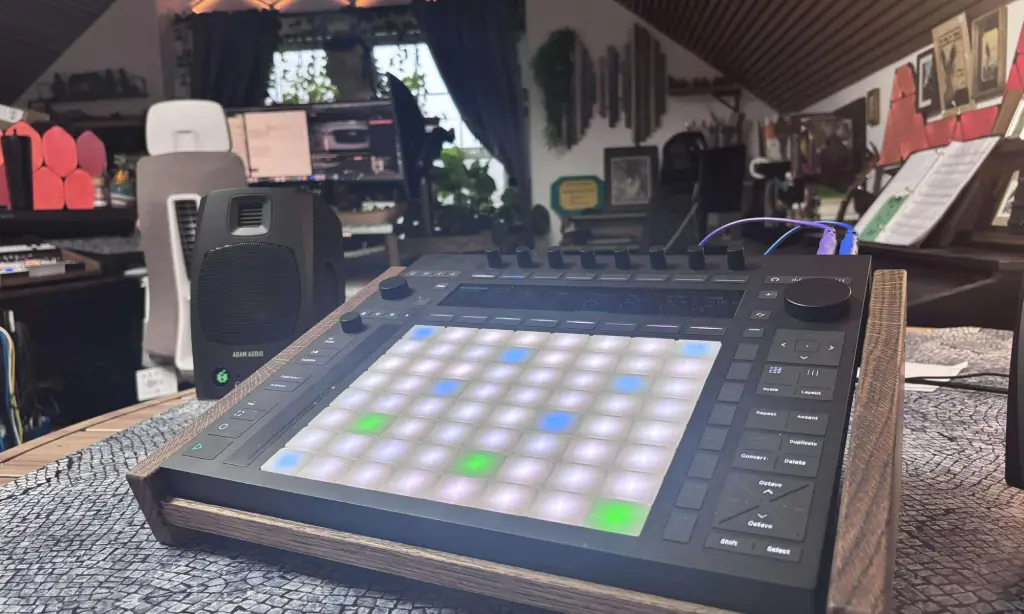
The D3V desktop monitors are ideal for producers, musicians, and creators seeking something accessible, reliable, and crystal clear. The versatility and compact design of these monitors are key advantages, even if some low-end warmth and high-end room correction options are sacrificed compared to competitors. However, the fact that you can get these monitors for under $300 is a significant factor here.
Personally, I’ve been pushing myself over the past few months to get out of my DAW and make more music. Using my Push 3 standalone mode has been great for exploring different angles and listening positions within my studio. Despite loving my Beyerdynamic open-back headphones, producing on headphones is a different vibe than producing on monitors. The D3V monitors arrived at a perfect time for me, becoming my go-to monitors over the past month when producing directly from my Push 3 standalone.
They offer angled pads that direct the tweeters right to my ears, clear and crisp output, and are incredibly user-friendly for moving around the studio. This adaptability has been invaluable for my workflow, as I produce from different angles and spaces within my studio, whether it’s on a walking pad, at my gaming table, or elsewhere. Their mobility and adaptability have been the real game-changers for me.
The ADAM Audio D3V Desktop Monitors combine high-quality sound, thoughtful design, and practical features into an affordable package. While they may not be perfect for every application, their strengths far outweigh their limitations. For most creators, the D3V represents a reliable, accessible entry into professional-grade monitoring.
Will Vance is a professional music producer who has been involved in the industry for the better part of a decade and has been the managing editor at Magnetic Magazine since mid-2022. In that time period, he has published thousands of articles on music production, industry think pieces and educational articles about the music industry. Over the last decade as a professional music producer, Will Vance has also ran multiple successful and highly respected record labels in the industry, including Where The Heart Is Records as well as having launched a new label with a focus on community through Magnetic Magazine. When not running these labels or producing his own music, Vance is likely writing for other top industry sites like Waves or the Hyperbits Masterclass or working on his upcoming book on mindfulness in music production. On the rare chance he's not thinking about music production, he's probably running a game of Dungeons and Dragons with his friends which he has been the dungeon master for for many years.
